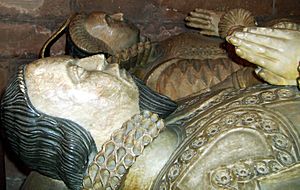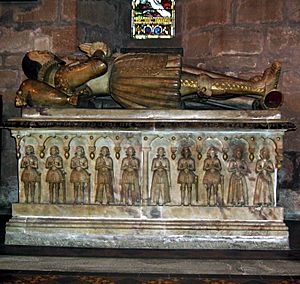John Giffard (died 1613) facts for kids
John Giffard (1534–1613) was an important Staffordshire landowner and a member of the English Parliament. He was well-known as a leader of Roman Catholics who refused to follow the new Church of England rules during the reigns of Queen Elizabeth I and King James I.
Contents
John Giffard's Early Life and Family
John Giffard's father was Sir Thomas Giffard. Their family home, Chillington Hall, had been in the Giffard family since the late 1100s. Both John's grandfather, Sir John Giffard, and his father, Sir Thomas, had made the family very wealthy. They owned a lot of land and were one of the richest families in Staffordshire. Even though they were Catholic, they generally accepted the changes that came with the English Reformation.
John's mother was Ursula Throckmorton. She came from another rich landowning family who also had strong Catholic beliefs. In 1539, when John was a child, his father bought Black Ladies Priory, which used to be a nunnery. The family moved there after Sir Thomas rebuilt it into a beautiful home. Around age 16, John Giffard married Joyce Leveson. Their first child, Walter, was born about a year later. By the time he was 21, John was ready to become a Member of Parliament.
Becoming a Member of Parliament
John Giffard was first chosen to be a Member of Parliament (MP) for Lichfield in October 1553. This was during the first parliament of Queen Mary I. Lichfield had not had MPs for a long time, but it got the right back in 1547. A powerful person named William Paget, 1st Baron Paget helped choose the MPs for Lichfield. John Giffard was a clear choice because he supported the Catholic Queen and had good connections in the area.
John traveled to London with his father, Thomas, who was also an MP for Staffordshire in the same parliament. Queen Mary's first parliament made laws to bring back Catholic practices in churches. However, it did not bring back the Pope's power or the monasteries. The Giffards agreed with these changes because they matched their own beliefs. This parliament only lasted two months.
John was also elected to the next parliament in April 1554. This time, he represented the town of Stafford. His colleague was Humphrey Swynnerton, who was married to John's aunt. Humphrey was a very religious Catholic. The elections in Stafford were decided by a small group of important citizens. John's own father, Thomas Giffard, was the High Sheriff of Staffordshire at the time, and he officially confirmed his son's election.
This parliament was even shorter, lasting only one month. Its main job was to approve Queen Mary's marriage to Philip of Spain and to pass a law that gave a ruling queen the same power as a king. The Giffards fully supported the Queen's wishes.
A Landowner and a Recusant
John Giffard's father, Sir Thomas, passed away in 1560. This left John with many large landholdings across Staffordshire and Derbyshire. The family's main home remained Chillington Hall. John's brother, Humphrey, was given Black Ladies Priory to live in.
When Queen Elizabeth I became queen in 1558, things changed for Catholics. The Queen quickly brought back a Protestant monarchy and the Church of England. At first, the authorities were not too strict about people's beliefs, only their church attendance. Many Catholics slowly started to follow the new rules. John Giffard became a Justice of the Peace and High Sheriff of Staffordshire in 1573. To hold these jobs, he had to take the Oath of Supremacy. This oath meant he had to swear that the monarch was the supreme head of the church in England. If someone refused this oath more than once, it could be seen as treason. The government wanted John Giffard to join the county's leaders.
In 1575, Queen Elizabeth visited Staffordshire and stayed at Chillington Hall. John Giffard promised to attend church services, but the Queen herself noticed he wasn't there. This was against the Act of Uniformity 1558, which required everyone to attend Church of England services. Just three days later, he was called before the Queen's advisors to explain himself. He was questioned by bishops and then placed under the care of a strict bishop. However, Chillington Hall needed repairs after the Queen's visit, so John was allowed to go home. Soon after, he was officially released, but only if he promised to attend church and use the Prayer Book even in his private chapel.
However, John Giffard continued to avoid attending parish church. Because of this, the Crown took control of his estates, and he was placed under house arrest. He could only stay at his homes in London or Chillington. The only exception was for visits to a spa for health reasons. Despite this punishment, John Giffard remained loyal to the Queen. In 1588, when England was threatened by the Spanish Armada, he swore loyalty and sent men to serve in the army.
What helped John Giffard later on was his son Gilbert's role in revealing the Babington Plot. Gilbert had gone to France in 1577 to study for the Catholic priesthood. He became involved in a plot against Queen Elizabeth I. However, he also secretly worked for Sir Francis Walsingham, the Queen's intelligence chief. When Gilbert returned to England, he was arrested but agreed to become a double agent for Walsingham. His information was very important in uncovering the plot. Gilbert was imprisoned and died in Paris in 1590. Because of Gilbert's actions, the authorities became less strict with John Giffard in his later years.
However, the Giffard family's wealth was badly affected by John's refusal to conform to the new church rules. Before he died, John tried to manage his estates and pay off debts. He made his will on August 27, 1613, and passed away the next day. He was buried in the Church of St Mary and St Chad in Brewood.
Marriage and Children
John Giffard married Joyce Leveson on April 10, 1550. Joyce was the daughter of James Leveson, a very rich businessman from Wolverhampton. Her family made a lot of money from trading wool and from renting church properties. James Leveson had bought Lilleshall Abbey, a former monastery, in 1539, and it became his family's home.
John Giffard and Joyce had at least 14 children who survived:
- Eight Sons:
- Walter – who inherited John's estates
- Richard
- Thomas
- Gilbert – the spy who died in Paris
- Giles
- George – a priest
- Gerard
- Edward
- Six Daughters:
- Mary – who married Robert Brooke
- Cassandra – who married Thomas Cassey
- Ursula – who married John Wakeman
- Frances – who married Edmund Powell
- Jane – who married Sir John Dormer
- Dorothy – who married Sir Walter Leveson




